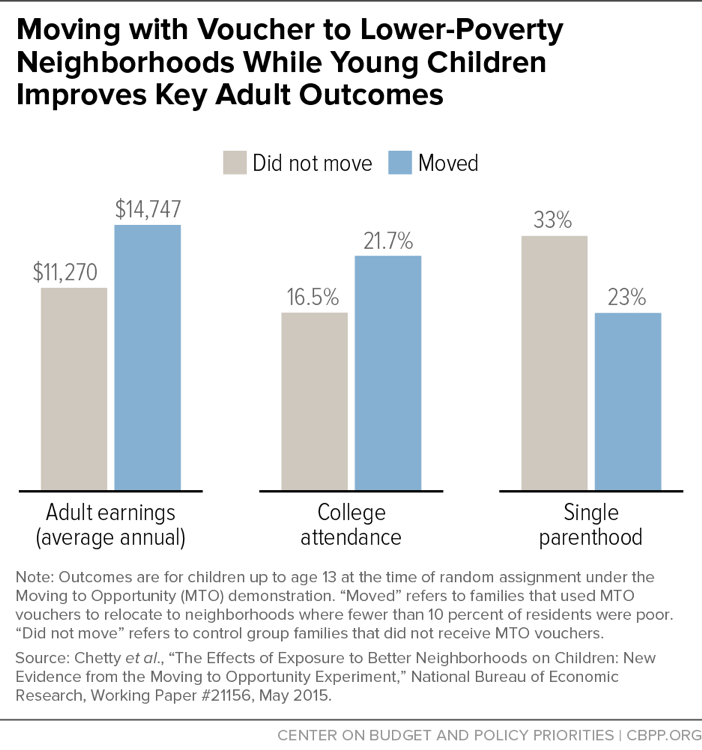BEYOND THE NUMBERS
The House Transportation, Housing and Urban Development appropriations subcommittee will consider this afternoon its fiscal year 2019 funding bill, which includes $50 million for a new Housing Choice Voucher mobility demonstration. Building on legislation from Sean Duffy and Emanuel Cleaver, the Republican chairman and ranking Democrat, respectively, of the House Financial Services Committee’s Housing and Insurance Subcommittee, appropriators have proposed a multi-year demonstration that would help more families with vouchers move to privately owned units in lower-poverty areas. These proposals show that policymakers — on a bipartisan basis — recognize the growing body of evidence that low-income families with children who move to low-poverty areas do better in the long term (see chart), and that they have identified increasing housing voucher mobility as a key to arresting intergenerational poverty.
We estimate that this demonstration will offer mobility services to over 22,500 families and that over 7,000 families will move to opportunity communities.
As part of the demonstration, the subcommittee bill would:
- Provide $30 million for housing mobility support services and operating regional mobility programs. Public housing agencies (PHAs) need additional resources to offer robust services to help families access communities of opportunity. These services include landlord outreach, housing search assistance, post-move support, and financial coaching. To supplement the funding for services, the bill would let participating agencies use voucher funding for security deposits in designated opportunity areas. The lack of funds for security deposits is a significant barrier for poor families to move to higher-opportunity areas where landlords require these payments.
- Provide up to $20 million for new vouchers for families with children participating in the demonstration. These approximately 2,000 additional vouchers would boost incentives for PHAs to undertake the substantial planning needed to meet the demonstration’s goals.
- Promote regional collaboration to simplify the moving process for families and make it more efficient for agencies. Rental markets are regional, but PHAs’ administrative areas are balkanized. There’s usually a center-city PHA surrounded by numerous suburban PHAs, which makes moving from another location onerous for families. Moving to an area served by another housing agency also puts families at risk of losing their ability to raise their earnings and savings through the Family Self-Sufficiency (FSS) program.
- Determine which program components are most cost-effective. Despite the operation of housing mobility programs in some areas, there’s little research to support which interventions are most cost-effective and beneficial to families. The bill contemplates building this evidence base through the demonstration, but available documents don’t specify whether the subcommittee will direct the Department of Housing and Urban Development (HUD) to use available evaluation funds for this purpose.
To ensure the demonstration has the greatest impact, the bill would require HUD to award funds on a competitive basis and prioritize regional collaborations among PHAs that have high concentrations of voucher holders in low-opportunity neighborhoods, a high-performing FSS program, or a strong regional collaboration including one or more small housing agencies, among other factors. HUD would have flexibility to decide how many grants to award.
The House should move forward with this well-designed, research-based solution to help the voucher program reach its potential. The Senate should include a similar provision in its 2019 appropriations bill.
CBPP will analyze other provisions in the House subcommittee appropriations draft in the coming days.

